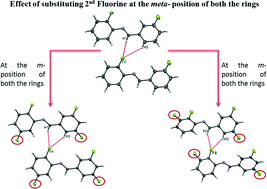A comprehensive understanding of the synthons involving C–H⋯F–C hydrogen bond(s) from structural and computational analyses†
Abstract
The studies of weak interactions involving “organic fluorine” have resulted in a number of conflicts in the literature. Although the involvement of a C–F group in influencing the crystal packing has been demonstrated in various compounds, no one has emphasized the consistency of the synthons formed by C–H⋯F–C hydrogen bonds. Herein, we have attempted to draw a correlation between the formation of a particular synthon and the positions of the fluorine substitutions from the structural analyses of a model system of tetrafluoro substituted N-benzylideneanilines. A few frequently occurring supramolecular synthons involving C–H⋯F–C hydrogen bonds have been identified in these and related molecules, and have been quantified by ab initio calculations using the MP2 level of theory and the 6-31+G* basis set in the gas phase. The topological properties of these C–H⋯F–C hydrogen bonds have been calculated using AIM2000. The nature, strength, directionality and synthon reproducibility of the C–H⋯F–C hydrogen bonds are the key features presented in this article.


 Please wait while we load your content...
Please wait while we load your content...